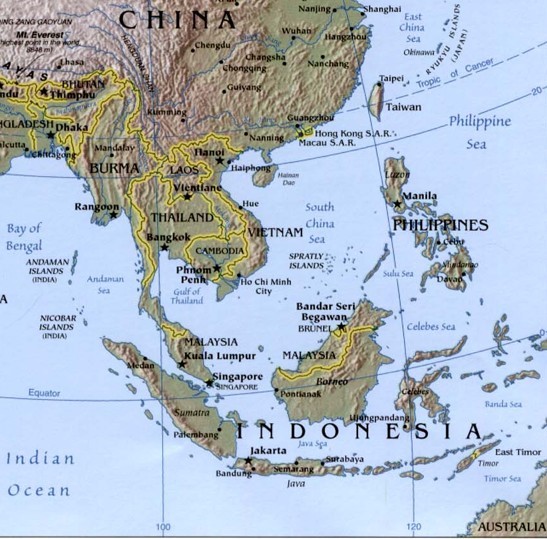Cha and Te
The character 茶 for tea was pronounced differently in different Chinese dialects. Seafaring merchants sailing from their native ports in southern China spoke a number of local and regional languages, including the widely disparate Cantonese of Guangdong province and the Amoy of Fujian. While trading in Southeast Asian waters, along the Malay Peninsula and the Indonesian island of Java, the Chinese encountered early European traders at the port cities of Malacca, Bantam, and Jayakarta and introduced the Westerners to tea. When speaking of the plant and leaf, the Chinese used the distinct languages of their different provinces.
The Cantonese pronounced the word tea as cha.[1] Cha also happened to be the spoken word for tea in the widespread Mandarin dialect. Linguistically, Cantonese and Mandarin together covered nearly three quarters of the country, that is to say, cha was the dominant pronunciation for tea throughout China. Tea as 茶 and cha extended beyond the continent to Korea and Japan, where the plant and herb were introduced from China as an important commodity and a feature of high culture and foreign diplomacy.
In southern Fujian, the Amoy spoke of tea as te.[2] Fujian was a major producer of fine tea. From the eighth century, the herb was traded widely as a noted commodity of the province. Unlike the Cantonese and Mandarin vocal cha, which had an extensive range throughout China and the Far East, the te of southern Fujian was markedly provincial.[3] But for centuries, the Amoy had traveled the sea as merchant mariners, migrating southward down the Fujian coast to Taiwan, Hainan Island, and throughout Southeast Asia. Their distinct language spread by the Chinese diaspora to Indonesia and Malaysia, expanding vastly the geographical range of tea as te.
Thus, Europeans dealing with Chinese traders in Asian ports heard two different names for tea, cha and te, the latter sound spawning a proliferation of Western spellings, including “té,” “tee,” “thé,” “thea.” Without universal agreement by either the Chinese or the Europeans on how to represent the tea plant and its leaf as cha or te, Western transcriptions of both names burgeoned, preceding the advent of dictionaries and then outpacing the lexicographical compilations of the mid seventeenth century.
As the premier powers in Far Eastern waters during the sixteenth century, the Portuguese and Spanish wrote tea as “cha,” ch’a,” “chá,” “chia,” “cia,” and “cià,” and created Latinate versions of te as “tay,” te,” “té,” “tè,” “the,” “thé,” and “thea.”
Notes
[1] Cha was also the spoken word in the several Mandarin dialects of the character 茶 and therefore the dominant pronunciation for tea throughout north, northeast, south, and southwest China, Korea, Japan, and even the Philippines, the latter influenced by the Portuguese and Spanish words for tea derived from cha. Cf. Edwin George Pulleyblank, Lexicon Of Reconstructed Pronunciation In Early Middle Chinese, Late Middle Chinese, And Early Mandarin (Vancouver: The University of British Columbia Press, 1991), p. 46 and Jerry Norman, “Common Dialectical Chinese,” The Chinese Rime Tables: Linguistic Philosophy And Historical-Comparative Phonology, David Prager Branner, ed. (Amsterdam: John Benjamins, 2006), p. 239.
[2] “Te” is pronounced teh and is phonetically transcribed as (tē) (International Phoentic Alphabet). The sea traders of southern Fujian province carried the Amoy and Hokkien dialects of Min Nan Chinese throughout Southeast Asia and Indonesia spreading the pronunication te for tea. For a study of the words for tea, see Victor H. Mair and Erling Hoh, “The Genealogy of Words for Tea,” The True History of Tea (London: Thames and Hudson, 2009), Appendix C, p. 264; cf. David Prager Branner, Problems in Comparative Chinese Dialectology: The Classification of Miin and Hakka (Berlin: Walter de Gruyter, 2000), p. 89.
[3] Note that in northeastern Fujian, tea or cha 茶 in the Fuzhou dialect was pronounced cha (tiä) and was similar to Cantonese and Mandarin.


